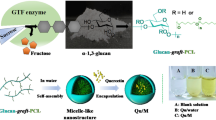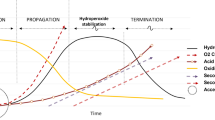Abstract
Three alkylcarbonates of γ-cyclodextrin, i.e. hexyl, octyl and dodecylcarbonate, were synthesized and characterized, with the goal of formulating solid nanoparticles. The series of alkylcarbonates showed amphiphilic properties and were capable of forming micelles and nanoparticles. Blank and drug-loaded alkylcarbonate nanoparticles were prepared with each alkylcarbonate, using the solvent injection technique. Progesterone was chosen as model drug. The sizes of both unloaded and loaded nanoparticles were in the 80–200 nm range, with narrow size distribution and spherical shape, as shown by TEM analysis.
The zeta potentials of unloaded nanoparticles were in the −20 to −24.0 mV range, and were slightly decreased in loaded nanoparticles. Drug-loading capacity was good; DSC analysis did not detect the progesterone melting peak, indicating the drug had interacted with the cyclodextrin alkylcarbonates. In vitro release kinetics of progesterone from the three types of nanoparticles were slow. These results indicate that γ-CD alkylcarbonate nanoparticles might be used as prolonged drug delivery system.




Similar content being viewed by others
References
Duchêne, D., Ponchel, G., Wouessidjewe, D.: Cyclodextrins in targeting application to nanoparticles. Adv. Drug Deliv. Rev. 36, 29–40 (1999)
Gèze, A., Aous, S., Bausanne, I., Putaux, J.L., Defaye, J., Wouessidjewe, D.: Influence of chemical structure of amphiphilic β-ciclodextrins on their ability to form stable nanopartides. Int. J. Pharm. 242, 301–305 (2002)
Dubes, A., Parrot-Lopez, H., Abdelwahed, W., Dagobert, G., Fessi, H., Shahgaldian, P., Coleman, A.W.: Scanning electron microscopy and atomic force microscopy imaging of solid lipid nanoparticles derived from amphiphilc cyclodextrins. Eur. J. Pharm. Biopharm. 55, 279–282 (2003)
Memişoglu-Bilensoy, E., Vural, I., Bochot, A., Renoir, J.M., Duchêne, D., Hincal, A.A.: Tamoxifen citrte loaded amphiphilic β-cyclodextrin nanoparticles: in vitro characterization and cytotoxicity. J. Controlled Rel. 104, 489–496 (2005)
Memişoglu, E., Bochot, A., Sen, M., Charon, D., Duchêne, D., Hincal, A.A.: Amphiphilic β-cyclodextrins modified on primary face: synthesis, characterization and evaluation of their potential as novel excipients in the preparation of nanocapsules. J. Pharm. Sci. 97, 1214–1220 (2002)
Trotta, F., Cavalli, R., Trotta, M.: Investigation of hetmolitie and complexation properties of γ-cyclodextrin carbonate derivatives. J. Incl. Phenomena Macroc. Chem. 44, 345–346 (2002)
Cavalli, R., Trotta, F., Trotta, M., Pastero, L., Aquilano, D.: Effect of Alkyl Carbonates of γ-cyclodextrins with different chain lengths on drug complexation and release characteristics. Int. J. Pharm. (submitted for publication)
Author information
Authors and Affiliations
Corresponding author
Rights and permissions
About this article
Cite this article
Cavalli, R., Trotta, F., Carlotti, M.E. et al. Nanoparticles derived from amphiphilic γ-cyclodextrins. J Incl Phenom Macrocycl Chem 57, 657–661 (2007). https://doi.org/10.1007/s10847-006-9269-9
Received:
Accepted:
Published:
Issue Date:
DOI: https://doi.org/10.1007/s10847-006-9269-9




